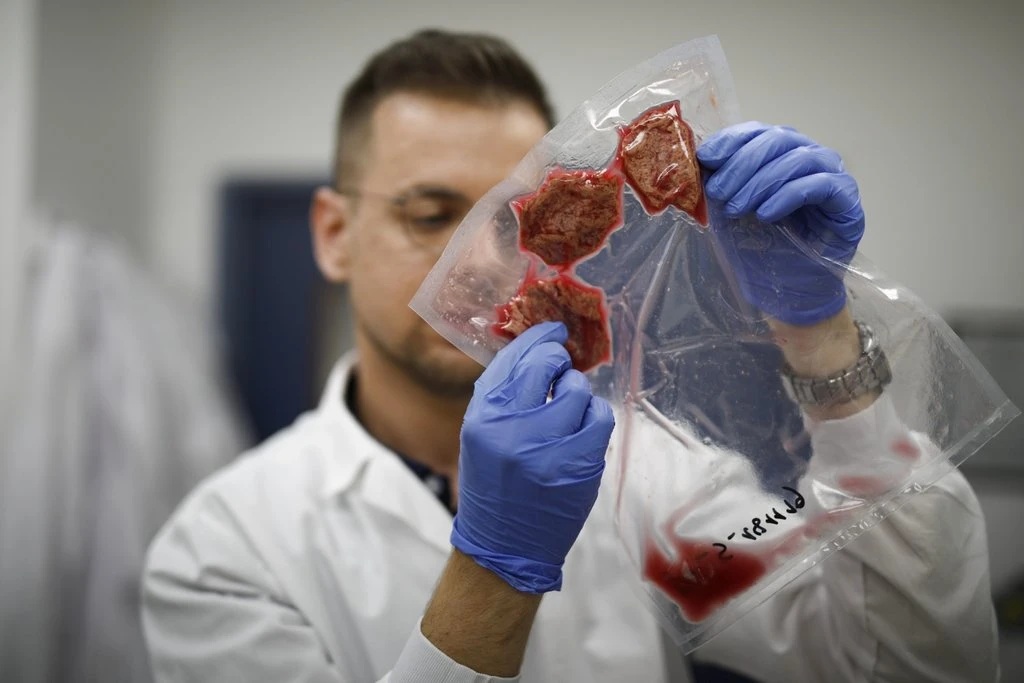Are You Ready to Eat Meat Grown in a Lab?

Human appetites are strange things. Most eaters (I include myself) will salivate at bacon, despite what we know of the waste, squalor and suffering caused by mainstream meat production. Yet when we hear about a new type of “ethical” meat with a much lower carbon footprint, cultured from cells without killing a single animal, our initial response is usually something like: “Ew! — I wouldn’t eat that.”
We should try to get beyond our disgust about “lab meat,” argues the journalist Chase Purdy, who is in the rare position of having actually tasted it. In a fast-paced global narrative, Purdy follows the various cell-cultured meat companies that are currently competing to get their product to market first. The front-runners are in Israel, the Netherlands and (no surprise) Silicon Valley. The results of what Purdy calls this “edible space race” may shape the future of meat eating around the world.
Meat that is grown in a vat doesn’t taste as bad as you might expect, according to Purdy.
It’s not as if conventional ground beef from feedlot cows tastes that great either when you really pay attention. In San Francisco, at the offices of the food company JUST, a lab tech serves Purdy a taco stuffed with duck chorizo grown from cells. The meat, he reports, is “moist and richly flavored.” The early prototypes of cell-cultured meat — grown from muscle stem cells — suffered from being too lean, but now the companies have figured out ways to grow fat tissue as well as muscle tissue, which means that the mouthfeel is getting closer to the meat we know (though it’s still easier to make a texturally plausible meatball than a convincing steak).
This is Purdy’s first book, and he sometimes falls into journalistic clichés. His story teems with the occasional “make-or-break” moment or a light bulb going off in someone’s head. But the upside is that his writing is always punchy and readable, even when he is explaining the complex and gruesome biology of growing a new piece of flesh from an old one. Sometimes there is a kind of Frankenstein fascination, such as in his description of how scientists at JUST have figured out a way to manipulate cells collected from the pointy tip of a chicken’s feather to become not just more feathers but also muscle and fat. Purdy explains that “scientists can take a cell that would normally live its life as a feather producer, tell it to stop working on feathers, and then revert it back into an earlier-stage cell.” In this way, cells from a single feather could give rise to multiple batches of chicken nuggets.
The snag is that these cell-grown nuggets would cost $50 apiece. Up until now, the biggest obstacle to getting cultured meat on the market has been the sheer expense — hence the “billion dollar burger” of Purdy’s hyperbolic title. When the first lab-grown burger was unveiled in 2013 by a panel including the Dutch food scientist Mark Post, it was estimated to have cost $330,000 for a single five-ounce patty: equivalent to $1.2 million per pound of beef. But that cost is falling, and fast. In 2019 an Israeli firm called Future Meat Technologies claimed that by 2022, it would be able to get cell-cultured meat on the market for as little as $10 a pound.
Even if it were cheap enough, would we want to add cultured meat to our grocery lists? Purdy says that the biggest barrier to getting these products to market in the United States is “a difficult regulatory landscape” influenced by meat lobbyists with a strong vested interest in keeping cell-cultured meat off the shelves.
We can’t blame the meat industry for all of our wariness around cell-cultured meat, however. Purdy concedes that many questions about this new technology remain unanswered. In the Netherlands, Post tells him that one of the many differences between traditional meat and cell-cultured meat is that the cell culture lacks an immune system. This sounds like it might just be important.
It’s too soon to say whether our “Ew” response to cultured meat is warranted or not. Many of the much-promoted novel foods of the past — margarine, I’m looking at you — turned out over time to be less healthy than was first thought. In a lovely passage, Purdy has a conversation in the kitchen with his aunt and grandmother about whether they would like to eat these new meats. “I’d have to get past the whole thought of it all,” his aunt replies. She’s not the only one.
Source : nytimes